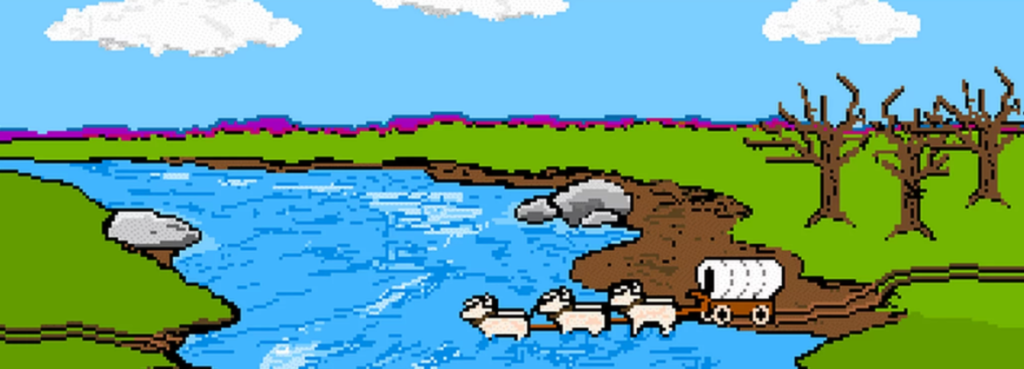Main Body
Chapter 3 – On the Trail of Educational Games: A Reception History of The Oregon Trail by Karen Bruce Wallace

On the Trail of Educational Games: A Reception History of The Oregon Trail
by Karen Bruce Wallace
You are a farmer from Illinois. You have heard of a new territory to the west in a place called Oregon. You’ve heard rumors of the rich and fertile land in the Willamette Valley, and believe it holds not only the potential for abundant crops but a fresh start for you and your family. You tell your wife that you are heading west, and she is nervous at first. She knows that not everyone makes the long and dangerous trip to Oregon, and she is scared of ending up in a hastily dug grave by the side of the road, but you are determined.
Selling your land, animals, and seed, you raise more money than you have ever had in your life: $400. You feel as wealthy as a king, until you arrive at the general store, and have to purchase supplies for the trip. Matt the shopkeeper is warm and welcoming, but many people have passed through his doors on the way to Oregon, and he is clearly determined to rich of the boom. Your money quickly dwindles to nothing, as you purchase oxen, food, clothes, and ammunition. Matt refuses to haggle, tapping his pipe, and saying someone else will pay for it. On the way out, you pass a banker, who has a team of eighteen sleek, well-fed oxen hooked up to his wagon, and you feel a pang of trepidation. Still, you quickly get over it. You will soon be in Oregon, and become richer than that banker.
A few days later, you and your family leave. At first, the journey is smooth. The oxen make good pace, the weather is fine, and your family is in good spirits. However, when you arrive at the Big Blue River Crossing, you try to ford it, and you meet with disaster. The river is too deep and the current too strong. It overwhelms your wagon, washing away two yokes of oxen and pounds of precious food, and causing your youngest son to drown. Your wife is distraught and wants to return to Illinois, but you have sacrificed too much, and need to push forward to make it worthwhile.
With fewer oxen, your pace is slower. Your provisions, already depleted by the accident at the river, begin to run out. When you attempt to trade with people, they are uninterested in anything you have to offer. When you try to go hunting, you only find squirrels, and they skitter away mockingly before you can hit them. Once, you see a buffalo in the distance, but it thunders off when you approach it. You put your family on bare bones rations, yet the food eventually runs out, and they begin to starve. Your daughters die, and your wife follows them soon after. You can see she has lost her will to live.
You press on without them, driven by your singular purpose. You will get to Oregon, and start a new life, a new family. Days later, you feel the chills begin, and your stomach cramp painfully within you. Shortly after, you die of dysentery.
Forging the Trail: A Brief History of Oregon Trail
In 1971, American schoolchildren began their journey along a digital version of the Oregon Trail, virtually tracing the wagon tracks of around four hundred thousand pioneers who had traveled the two thousand miles from Missouri to Oregon in the nineteenth century. Assuming the role of banker from Boston, a carpenter from Ohio, or a farmer from Illinois, they made decisions about when to leave, what supplies they needed to purchase and how best to manage them, and how to navigate situations such as crossing rivers, choosing a path to follow, or hunting for food. In the process, their pioneers were afflicted by a series of random and terrible misfortunes, managing to lose their way on the trail, be robbed of pounds of food and yokes of oxen, and suffer from broken limbs, typhoid, and, of course, the ever-present dysentery. With good management and some luck, they would make it safely to Oregon.